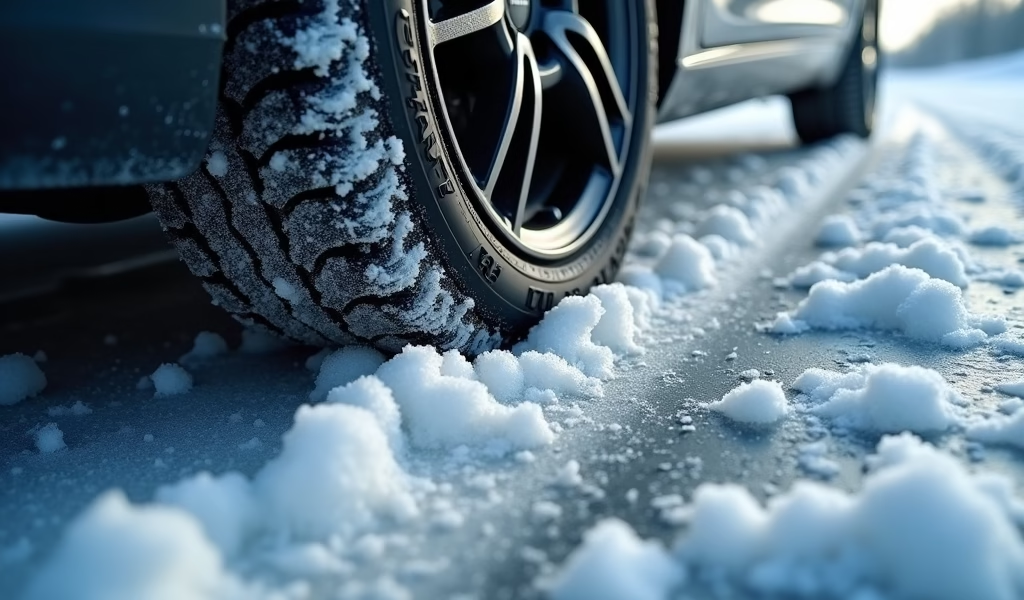Overview
Winter tire compounds utilize specialized chemistry—including high silica content, natural rubber, micro-pore technology, and temperature-sensitive polymers—to maintain flexibility and grip in freezing conditions where standard tires become rigid and ineffective. Proper maintenance of these specialized compounds through correct storage and care is essential for preserving their cold-weather performance capabilities, which typically remain optimal for 4-6 winter seasons.
Table of Contents
- Understanding Winter Tire Compounds: The Chemistry Behind Cold-Weather Grip
- Tip #1: Silica Content – The Secret Ingredient for Cold-Weather Flexibility
- Tip #2: Natural Rubber Percentages – Nature’s Cold-Weather Solution
- Tip #3: Micro-Pore Technology – Creating Tiny Snow Magnets
- Tip #4: Temperature-Sensitive Polymers – Smart Materials for Changing Conditions
- Tip #5: Maintaining Compound Integrity – Protecting Your Winter Tire Investment
- Conclusion: The Science That Keeps You Safe
- Frequently Asked Questions
Understanding Winter Tire Compounds: The Chemistry Behind Cold-Weather Grip
When temperatures drop and roads turn treacherous, your tires’ rubber compound becomes your lifeline to the road. As a mechanic who’s spent decades helping folks navigate winter driving, I can tell you that winter tire compound chemistry isn’t just technical jargon—it’s the difference between confident control and white-knuckle anxiety when roads get slick.
Most drivers understand that winter tires have different tread patterns, but what truly separates them from all-seasons is their rubber composition. Regular tire compounds become stiff as a board when temperatures plummet, but winter compounds remain pliable, almost like comparing frozen taffy to room-temperature taffy.
This magical winter tire flexibility comes from specialized chemistry that works at the molecular level. Through years of testing in extreme conditions from the Arctic Circle to the Alps, tire engineers have developed rubber compounds that maintain grip when ordinary tires would skate across the surface like hockey pucks.
Let’s dive into the five most important aspects of winter tire compound chemistry that you should understand before the first snowflake falls. These insights might sound technical, but I’ll break them down in ways that make practical sense for your winter driving needs.
Tip #1: Silica Content – The Secret Ingredient for Cold-Weather Flexibility
If you could peek inside a winter tire’s rubber recipe, you’d find silica playing a starring role. Think of silica as nature’s anti-freeze for rubber compounds. Traditional tire compounds rely heavily on carbon black (essentially, sophisticated soot), but winter tires substitute higher proportions of silica to maintain flexibility when temperatures nosedive.
Here’s why this matters: when temperatures drop below 45°F (7°C), the temperature rating classification of standard compounds causes them to harden dramatically. The molecular structure essentially locks up, like water freezing into ice. Silica prevents this hardening by creating a more temperature-resistant molecular structure.
Premium winter tires typically contain 15-25% silica in their tread compounds, compared to just 5-10% in summer tires. This isn’t just marketing fluff—it’s chemistry that translates directly to grip. When I’m checking tires in my shop, I can actually feel the difference by pressing my thumb into the tread blocks of winter versus all-season tires at cold temperatures.
When shopping for winter rubber, look for terms like “high-silica compound” or “enhanced silica technology” in the product descriptions. These aren’t just buzzwords; they indicate tires specifically formulated to maintain flexibility when the mercury plummets. Manufacturers who’ve invested in advanced silica technology typically highlight it in their technical materials.
The best winter tires from brands like Bridgestone, Michelin, and Nokian use proprietary silica-enriched compounds that have been tested in extreme Arctic conditions. According to Tire Rack’s winter tire testing data, high-silica winter tires can maintain flexibility down to -40°F (-40°C)—conditions where standard compounds become virtually useless.

Tip #2: Natural Rubber Percentages – Nature’s Cold-Weather Solution
Mother Nature had winter driving figured out long before we started building cars. Natural rubber, harvested from rubber trees, has inherent properties that synthetic alternatives struggle to match in frigid conditions. That’s why quality winter tires contain significantly higher percentages of natural rubber than their summer counterparts.
Natural rubber contains long, flexible polymer chains with a molecular structure that resists stiffening in cold weather. It’s similar to how wool stays warm and flexible even when wet, while synthetic materials often become stiff and uncomfortable. These natural polymers maintain their elasticity even when temperatures drop well below freezing.
In my shop, I’ve witnessed the difference between budget winter tires with lower natural rubber content and premium options that use up to 35-40% natural rubber. The difference is dramatic when temperatures drop below 0°F (-18°C). Budget tires with higher synthetic content start to lose pliability, while the natural-rubber-rich compounds remain workable.
The tire compound durometer rating, which measures rubber hardness, tells much of the story. Premium winter tires maintain a lower durometer (softer feel) at freezing temperatures compared to standard tires, largely due to their natural rubber content. This translates directly to better grip on snow and ice.
There’s a trade-off, though. Natural rubber is more expensive than synthetic alternatives, which is partly why good winter tires cost more. It’s also why premium winter tires wear faster in warm conditions—that soft, pliable compound that works wonders on ice will wear quickly on warm pavement.
When examining winter tire options, look for terms like “high natural rubber content” or references to special natural rubber formulations. These indicate compounds specifically designed to maintain flexibility in extreme cold—exactly what you want when navigating an icy parking lot or snow-packed road.
Tip #3: Micro-Pore Technology – Creating Tiny Snow Magnets
Some of the most effective winter tire technology works on a scale so small you need a microscope to see it. Micro-pore technology incorporates thousands of tiny cavities throughout the rubber compound that function like microscopic snow magnets, dramatically improving traction on snow-covered surfaces.
These tiny pores work through a counterintuitive principle: to get better grip on snow, you actually need to hold onto some snow. When a micro-pore winter tire rolls over snow, the pores temporarily collect snow particles. This creates snow-on-snow contact points between your tire and the road surface, which generates much better traction than rubber-on-snow contact.
It’s similar to how making a snowball works best when you have a bit of snow already on your gloves. The snow sticks to snow better than it sticks to dry gloves. Your tire effectively creates thousands of tiny snowballs that grip the snowy road surface, then releases them as the tire continues to roll.
The chemistry behind this is fascinating—these pores are created using special compounds that release gas during the vulcanization (curing) process, leaving tiny voids in the finished rubber. Some manufacturers enhance this effect by adding hydrophilic (water-attracting) materials around these pores that draw in moisture and improve the snow-adhesion effect.
When I’m examining tires for customers concerned about deep snow performance, I often recommend options with advanced micro-pore technology. Under magnification, you can actually see these tiny cavities throughout the rubber compound—they look like a sponge’s structure but on a microscopic scale.
Nokian, the Finnish tire manufacturer that literally invented the winter tire, pioneered this technology with their “Cryo-Crystal” concept. Other manufacturers have followed with their own versions, using terms like “micro-pump technology” or “snow voids.” According to Nokian’s research, these microscopic features can improve snow traction by up to 8% compared to similar compounds without this technology.
Tip #4: Temperature-Sensitive Polymers – Smart Materials for Changing Conditions
Modern winter tires are like chameleons of the road, adapting to changing conditions through sophisticated polymer science. Advanced winter compounds contain temperature-sensitive polymers that actually alter their behavior based on the conditions you’re driving through.
These specialized polymers function through a property called “glass transition temperature”—the point at which rubber transitions from pliable to rigid. By carefully engineering polymer blends with different transition points, manufacturers create compounds that maintain optimal flexibility across a wide range of winter temperatures.
The most advanced winter tires use multi-phase polymer systems where different components of the rubber compound serve different purposes simultaneously. Some polymers optimize grip on ice, others enhance snow traction, and still others maintain stability on cleared pavement. This creates a tire that handles the mixed conditions winter drivers actually face.
In my years working with winter tires, I’ve seen dramatic improvements in this technology. Early winter tires performed well in a narrow temperature range but could feel wooden when extremely cold or squirmy when temperatures hovered near freezing. Today’s advanced polymer formulations provide more consistent performance across the full spectrum of winter conditions.
The sidewall construction materials of winter tires often contain these same smart polymers to maintain flexibility in cold weather, preventing the sidewalls from cracking under extreme conditions. This whole-tire engineering approach ensures all components work together in harmony.
When researching winter tires, look for marketing terms like “adaptive compound technology” or “multi-cell compounds.” These indicate the presence of these sophisticated temperature-sensitive polymer systems. Major manufacturers have their own proprietary technologies—Bridgestone’s “Multi-Cell Compound,” Michelin’s “EverGrip Technology,” and Continental’s “PolarPlus Technology” are among the industry leaders.

Tip #5: Maintaining Compound Integrity – Protecting Your Winter Tire Investment
Winter tire compounds represent a significant investment in your safety, but their specialized chemistry makes them particularly vulnerable to degradation if not properly maintained. As someone who’s seen countless prematurely aged winter tires, I can tell you that proper care extends their effective lifespan dramatically.
The natural rubber and specialized polymers that make winter tires effective are also more susceptible to environmental damage than standard compounds. Heat, ultraviolet light, ozone, and certain chemicals can all break down these compounds, compromising their cold-weather performance even if the tread depth looks fine.
Here are practical steps to protect your winter tire compound integrity:
- Store winter tires in a cool, dry place away from direct sunlight during off-seasons
- Keep tires away from ozone sources like electric motors, furnaces, and sump pumps
- Use tire bags or covers specifically designed for storage
- Clean tires with mild soap and water only—avoid petroleum-based tire dressings
- Store tires at approximately 10 PSI (not full pressure, but not completely flat)
- Stack tires horizontally or hang them from proper wheel hooks—never stack them on the tread face
One maintenance mistake I frequently see involves using harsh chemical cleaners or “tire shine” products on winter tires. Many of these products contain petroleum distillates that can extract plasticizers from winter tire compounds, accelerating aging and reducing cold-weather flexibility.
According to research from Consumer Reports’ tire testing division, improper storage can reduce winter tire lifespan by up to 30%. Considering winter tires typically cost $600-1,200 per set, proper storage represents significant savings over time.
I also recommend maintaining proper inflation pressures throughout the winter season. Under-inflated winter tires generate excessive heat, which can damage the specialized compounds. Check pressures weekly during winter, as cold ambient temperatures cause pressure to drop approximately 1 PSI for every 10°F decrease in temperature.
Remember that even properly stored winter tires have a finite lifespan. The specialized compounds typically maintain optimal performance for about 4-6 winter seasons, regardless of tread depth. If your winter tires are older than 6 years, consider replacement even if they look fine visually—the compound chemistry has likely deteriorated.
Conclusion: The Science That Keeps You Safe
Winter tire compound chemistry represents one of the most significant yet least understood safety advances in modern vehicles. These specialized rubber formulations work silently beneath your car, maintaining grip in conditions where standard tires would leave you sliding helplessly.
The five key aspects we’ve explored—silica content, natural rubber percentages, micro-pore technology, temperature-sensitive polymers, and compound maintenance—work together to create tires that perform when ordinary rubber would fail. This isn’t just about getting better traction; it’s about maintaining control when you need to brake suddenly on an icy hill or navigate through unexpected slush.
As someone who’s spent decades helping drivers prepare for winter conditions, I’ve seen the real-world differences these specialized compounds make. The driver with quality winter tires properly maintained stops several car lengths shorter than the one who thought all-seasons would suffice. That distance can be the margin between a close call and a collision.
Winter driving presents enough challenges without adding poor traction to the mix. By understanding and investing in the right winter tire technology for your climate and driving needs, you’re giving yourself an invaluable advantage when conditions deteriorate. After all, those four hand-sized contact patches are all that connect your vehicle to the road—make sure they’re up to the job when winter does its worst.
Frequently Asked Questions
How do winter tire compounds differ from all-season compounds?
Winter tire compounds contain higher percentages of silica and natural rubber that stay flexible in freezing temperatures. All-season compounds become stiff and less grippy below approximately 45°F (7°C), while winter compounds maintain pliability and traction in subfreezing conditions.
At what temperature should I switch to winter tires?
Most tire manufacturers recommend switching to winter tires when average temperatures consistently fall below 45°F (7°C). This temperature threshold marks where winter compounds begin to outperform all-season rubber regardless of whether snow is present.
Can I use winter tires year-round?
Using winter tires year-round is not recommended as the soft compounds wear rapidly in warm weather and may provide less responsive handling. The specialized polymers in winter tires are designed for cold temperatures and will deteriorate faster when used in hot conditions.
How much do silica levels affect winter tire performance?
Silica content significantly impacts winter performance, with higher-silica tires (15-25%) maintaining flexibility in extreme cold where standard compounds become rigid. In independent testing, high-silica winter compounds typically improve braking distances on ice by 10-15% compared to lower-silica alternatives.
How long do winter tire compounds remain effective?
Winter tire compounds typically maintain optimal performance for 4-6 winter seasons, even if tread depth remains adequate. The specialized polymers and natural rubber components gradually degrade with age and exposure to environmental factors, so tires older than six years should be replaced regardless of visual condition.

